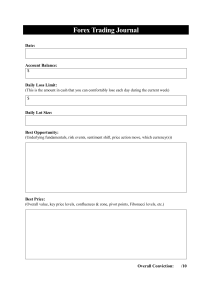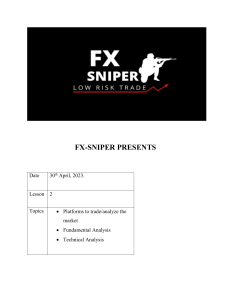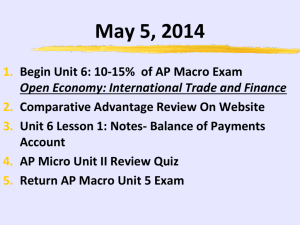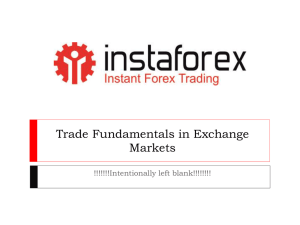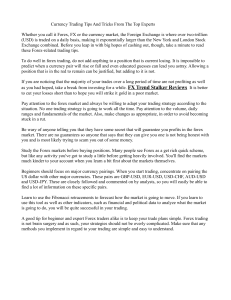Forex Trading for Beginners: A Comprehensive Guide
advertisement
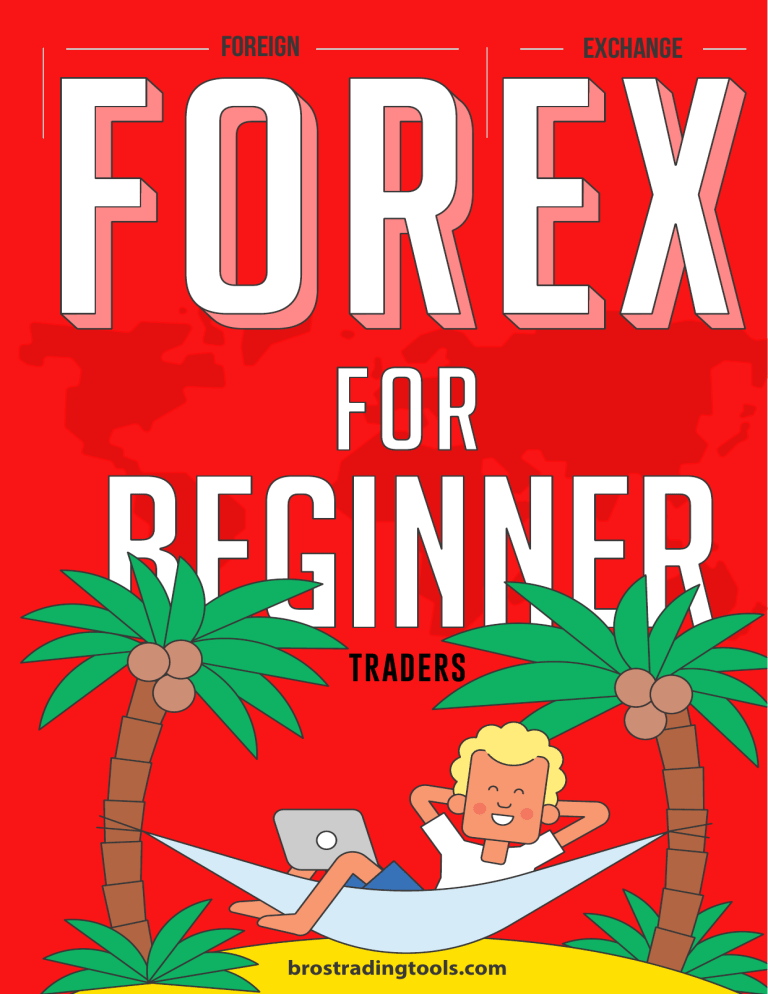
FOREIGN EXCHANGE FOREX FOR BEGINNER TRADERS brostradingtools.com BEFORE YOU INVEST IN SOMETHING, INVEST TIME TO UNDERSTAND IT /WARREN BUFFETT/ Actual net worth $79B 💸 📕 About this e-book Many moons ago when the iPhone was just a glint in Steve Jobs’ eye, we started trading currencies. As our journey progressed, it was immediately obvious that finding any useful trading advice for a beginner was almost impossible. The lack of general information was bad, but things got even worse when we needed to find specific answers related to forex. 😤 😔 When we were able to find something helpful, the forex focused material lacked depth and it was often scattered wildly around the web. If you wanted to learn about leverage it would be on one website, while information about Forex fundamentals would be on another and useful tips somewhere else yet again. 😢😠 We knew there had to be a better way how to learn Forex Trading. So we built it. 💪🏆 Now we have the free “Forex Trading For Beginners” e-book. Here you can find absolutely everything you need to start learning to trade currencies. 👏 💵 We did the research for you, to help you in the b est broker in 2023 We compared losing rate, commissions, social trading feature, customer service, practically everything. We went deep, so you won't have to. This e-book was created with the sole purpose of providing a trustworthy and straightforward resource so you can learn all the fundamentals of forex trading without the need to endlessly trawl through Google searches. 🙌 We don’t claim to have any secret magic tips on Forex trading. You’re not going to hear anyone suggesting you will make a trillion dollars a week or that you will be buying your private island next month. Instead, what this book offers is a safe haven for newbie traders. 🏝 We promise there are no claims of easy money nor holy grails here; just useful advice, well organised and simply written to help you learn as much about forex trading as possible. ✌ Why People ♥ Forex? Start with $100 Until the early 2000’s, it was not possible to trade forex markets with anything less than $10,000. Unlike other financial markets, you can trade with much smaller amounts such as $100. More and more players are entering the forex market, allowing you to leverage your capital and make money from fluctuations in the forex market. 💵 Work While Lying in a Hammock You can literally trade forex markets while sipping on a cool drink and lying in a hammock. All you need to get started is some capital to trade with, a computer, laptop or smartphone and an internet connection. You decide when you want to trade and therefore your working hours. 📱 No crisis Even during a financial crisis, you can still make money trading forex markets. Any oscillation in the currency can be taken advantage of by going long or going short. Whether a market is bullish or bearish, you can trade either way with forex unlike stocks or other financial instruments. 📉 📈 Learn from Pros with social trading You can watch what professional traders are doing and 💸 💸 observe their trades with social trading . Social trading lets you copy other trader’s strategies and can be very beneficial to newcomers, shortening the learning curve. In the past, traders relied on funda-mental and technical analysis, but with social trading, you can take cues from successful traders to make ✌ money on forex. 🏽 Easy rules The forex market is quite straightforward as compared to other financial markets. With stocks, you have to analyse company reports and choose from thousands of companies to invest in. However, forex markets generally revolve around eight currencies, known as the Majors. Put simply, the better a country’s economy is doing, the better we expect their currency to perform. 😴 🏃 How to Trade if You Are a Busy Person 👉 If you are too busy to follow the news and monitor the charts all day, it is possible to participate in Forex trading in an easier and less time consuming way. Social trading allows you to connect with experienced traders, see their performance statistics, discuss their trading ideas, learn from their mistakes and copy their successful strategies. In essence, you make professionals work for you. 👈 1 Choose a Platform Even if you are new to Forex, there are beginner friend- ly platforms like ETORO (10 millions users) that offer you an interesting opportunity - to follow the best traders and copy their transactions. 2 Follow Top traders Discover traders you want to follow and add to your watch list. View their past performance stats, read status updates on their strategies, analyze results and communicate with them. 3 Copy their trades If you are satisfied with the results and trading style, you can copy their trades with one click of a button. 4 Learn and Profit Now you can sit back and watch how experienced traders do the work for you. Your task is to carefully analyze their results and learn as much as possible from their trades. The ultimate goal of social trading is to build a portfolio of the best traders. You must have traders with different risk appetite and various currency What is Leverage, Pip & Spread 🤓 1 Leverage Leverage, which represents a margin trading ratio, enables traders to borrow a certain amount of money that allows them to trade in much bigger deals. Moreover, leverage allows one to trade using more money than they have in their account. Therefore, you “leverage” your account’s balance to place a bigger trade. Currency rates move very slowly. This makes small trades unfashionable as they only return small profits and losses for every pip rate changes. Therefore, leveraging helps one to trade in larger deals hence amplifying their potential profits and losses. 2 Pip Price Interest Point represents the smallest change in a currency pair. Typically, it is the fourth decimal point, although many brokers quote using the fifth decimal. However, the fifth decimal doesn't really affect the price as it changes really quick. Currency pairs that include the U.S. dollar, a pip is 1/10, 000 of a dollar, whereas when the currency pair includes the yen, a pip is 1/100 of a yen because the yen is closer in value to 1/100 of other major currencies. 3 Spread In Forex trading, brokers quote the bid and ask price for the currency pairs. The bid is the price that a trader can sell the base currency while the ask is the price they can buy the base currency. Spread refers to the difference between the two prices. Besides, this is how the “no commission” brokers- those who do not charge a separate fee on traders’ transaction- make their money. The spread is measured in pips. Most currency pairs- the base currency and quote currency- have a pip value equal to 0.0001. For instance, take the following quote; EUR/USD = 1.1051/1.1053 the spread is 0.0002, which equates to 2 pips. What is Forex? Find Out Here! 👇 ℹ In the forex market, $5.3 trillion is traded daily, making it the largest and most liquid market in the world. ℹ The trade in Forex occurs between two currencies, because one currency is being bought and another - sold at the same time 👉Point (Pip) The fourth unit after the decimal point, which is the smallest unit of an exchange rate 👉Spread The difference between the sell quote and the buy quote (in pips) How To Read Currency Pairs? 🔊 Currencies are traded in pairs as their value is relative to one another. The first currency shown is the controlling one in terms of placing your order. So if you see EUR/USD then you are always choosing to buy or sell the first currency (Euro) against the second currency (U.S. Dollar). MAJORS are widely traded by beginners and professionals alike. This is because they have the most liquidity, lowest spreads and the broadest range of movements. Unlike small currencies, majors are generally more stable. The economic and political institutions of these nations are generally long established and predictable compared to other nations. THE CROSSES are any currency pair that doesn’t feature the USD and they do not hold any less profit potential than the majors. Too much US Dollar exposure can lead to all your trades heading in the same direction, a big problem if that direction is against you. THE "EXOTIC" currency pairs are less traded and so much more costly to buy or sell. Don’t let the cost put you off, because many of the greatest traders of all time made their fortunes with exotics. For example, one of the 5 greatest forex traders, George Soros gained $800 million profit from selling Thai Baht (THB) in 1997 Asian crisis. How Leverage Works? 🤔 Leverage in Forex trading is all about entering borrowed capital into transactions. The money is borrowed from a broker who acts like a bank that fronts you some cash to invest, which in this case is to buy currencies. Take the options shown below: 🅰 Leverage of 1:20 🅱 Leverage of 1:200 With a margin trading ratio (leverage) of 1:20, option A allows a trader who has invested $100 to trade with US $2,000. Moreover, if the pip value changes by +0.0030, the trader makes a profit of $6 hence increasing the balance in their account to $106, thus an ROI of 6%. On the other hand, option B allows one to trade with $20,000 and makes a $60 profit. The trader’s closing balance in their account would be $160 with an ROI of 60%. This shows that the higher your leverage, the higher your chance of a better ROI. ‼ Tips and warnings when using Leverage ‼ ⚠Keep your losses within manageable limits. Well, professional traders advie that one shouldn’t risk all their money in one transaction. Besides, a trader should diversify their risk by spreading it out to about 5% of their total deposit per trade. In case of any losses, they’ll not only be small but will not get out of hand. ⚠ Use Stop-Loss Orders and other strategic stops. The stop loss order lets your broker know to sell a currency when it hits a certain set price. These stops work around the clock in the forex market, therefore, protecting your position when you are logged out of the system. In addition, the strategic stop caps the losses while also protecting the profits. ⚠ Always start slow at first. This helps in building the novice traders’ experience and confi- dence in their early days of trading. Once you’ve learned the ins and outs of forex trading, you can consider increasing the leverage. When To Trade Forex? ⏰ While the Forex market is open 24 hours a day, five days a week, trading is not always active during this entire time. Profits are made in forex trading when traders are bidding on the prices and the market is active. So it is essential that you know the crucial hours and days of forex trading when traders are the most active. ⌚ As a global market, forex spans multiple time zones. As a result, there are three main forex trading sessions you should be aware of; the Tokyo (or Asian) session, the London (or Eurpoean) session and finally the New York (or American) session. The busiest times are when these sessions overlap, for example, in the early hours of the morning in London, the trading session in Tokyo is just winding down. European traders are getting to their desks and analyse and digest information from the Asian trading session, so early 6am (GMT) is a great time to make trades - as the saying goes, “the early bird gets the worm.” ‼The London session is usually the most active and in the afternoon overlaps with the opening of the New York or American session, so there can be good opportunities to trade forex and make a profit. ‼ Seasoned traders considered 10am (EST) to be the best time to trade forex markets as during this time, traders in London and Europe are preparing to close their positions and traders are getting ready to make a move in the American session. As the focus shifts from Europe to the US, this often creates big swings in currency prices, opening up opportunities to profit. The Best Time of the Week to Trade Forex Research has found that the biggest movements in four of the major currency pairs - namely EUR/USD, GBP/USD, USD\JPY and USD/CHF - are observed on Tuesdays and Wednesdays. These days generally show the biggest movements in currencies as major data releases related to the economy are usually released on these days. Fridays are busy as well, but only until 12am. During the second half of Friday, movements can often be unpredictable since major banks, hedge funds and financial institutions will close some of their positions for safety reasons over the weekend. 🙅🏻 When NOT to Trade Forex? 🙅🏻 ⛔ ⛔ ⛔ ⛔ Bank Holidays Friday Afternoons and Weekends End of December When Angry or Frustrated ⛔ ⛔ ⛔ ⛔ Asian Sessions Release of News Events Market Closing Time Overnight Experienced traders avoid trading on Friday afternoon and weekends, on closing session, on bank holidays, on Christmas, during Primetime TV events, when major economic reports and news are released, and when they are angry, frustrated and exhausted. Also, novice traders should be very careful with the Asion sessions. What Are Bulls And Bears in Forex? You think a currency will FALL You SELL the currency You open a SHORT position 🐻 You think a currency will RISE You BUY the currency You open a LONG position 💵 In Forex Market You can SELL or BUY currencies 💵 When you SELL you are said to be BEARISH Bearish candlestick Bearish trend When you BUY, you are said to be BULLISH Bullish candlestick Bullish trend How To Read Charts In Forex? 📈📉 Let's look at the three most popular types of forex charts: line chart, bar chart, and candlestick chart. 1 Line Chart It is the most basic of all forex charts. It is created by simply connecting the data points depicting the closing prices of certain periods with a line. Although it doesn’t include the opening, high and low prices, the line chart can give the trader an idea of how the price of a currency has changed over a given time frame. Therefore, they can track its closing prices accurately. 2 Bar Chart Unlike the line chart, the bar chart not only shows the closing prices but also depicts the opening, high and low prices of a certain period. The graph is made up of a right and left dash, which shows the closing and opening prices respectively and a vertical bar showing the currency’s low and high prices (trading range). They are also called the OHLC charts in reference to the Open, High, Low and Close values of the currency under consideration. 3 Candlestick Chart They are the most popular charts among Forex traders. These charts are similar to bar charts only that they present the price information in an aesthetically pleasing graphic format. It also concentrates more on the opening and closing prices of the trading period. Besides, unlike the line chart, which shows the closing prices, it charts the opening, high, low and closing prices of a currency pair over each period using “candlesticks.” The candlestick’s height depicts the high-low for that period while its width shows the difference between the opening and closing prices. TOP 20 Terms in Forex Trading 🏅 Decoding the most common terms used in forex will speed up your understanding of the world of currencies 💪 👉Currency nicknames👈 👉Currency pairs👈 👉Popular phrases 👈 👉Bloomberg News examples👈 ✔ Cable - GBP/USD (British pound / U.S. ✔ Single Currency - EUR (Euro) dollar) ✔ Loonie - CAD (Canadian dollar) ✔ Ninja - USD/JPY (U.S. dollar / Japanese ✔ Swissie - CHF (Swiss franc) yen) ✔ Aussie - AUD (Australian dollar) ✔ Fiber - EUR/USD (Euro / U.S. dollar) ✔ Kiwi - NZD (New Zealand dollar) ✔ Chunnel - EUR/GBP (Euro / British pound) ✔ Greenback, Buck - USD (U.S. dollar) ✔ Sterling, Pound sterling - GBP (British pound) ✔ Yuppy - EUR/JPY (Euro / Japanese yen) ✔ Barnie - USD/RUB (U.S. dollar / Russian ✔Going Long - Opening a Bullish (buying) trade ✔ Going Short - Opening a Bearish (selling) trade ✔ Cutting Short - To close a losing position early ✔ Plunging - A price that's sinking or falling from it's previous value ✔ Currency rallying - A price that recovers after a period of its decline ✔ Position Trading - Trading with huge stop-losses for several months to years, without being too concerned with short term movements in asset prices ✔ USD/CAD - Dovish BOC hurts the loonie - Bank of Canada reports an interest rate cut, therefore Canadian dollar depreciates against U.S. dollar AUD/USD - Job report ruined the rally - Bad Australian employment report stopped recent AUD/USD uptrend NZD/USD - Signs of recovery for the rollercoaster kiwi - New Zealand dollar recovers against U.S. dollar after an extended exchange rate fall. ✔ ✔ What Moves Forex Market? 🤔 Even if you don't have time to stare at charts all day long, you can spot great trading opportunities by simply viewing the news and economic calendar on a daily basis. In other words, by performing fundamental analysis. Basically, all fundamentals are indicators of where investors intend to put their money and which currencies will be influenced as a result. All the drivers are divided in 4 major categories: central banks, state economics, political stability and natural disasters. Politics Economics Central Banks Natural Disasters 👉 Public Statements 👉 GDP, inflation, debt 👉 Finance Circulation 👉 Hurricanes 👉 Change of Officials 👉 Sales amounts 👉 Interest Rates 👉 Stability of governments 👉 Interest from investors 👉 Mandatory Reserve Funds 👉👉 Earthquakes Floods 💸 In the chart below you can see how the British Pound dropped because of the Brexit related events. This was a great opportunity to make money shorting (betting that it would decline) the British Pound. 6 Biggest Forex Market Movers 1 2 Inflation An economy’s inflation rate is one of the main determinants of a country’s exchange rate, defined as the general price level of goods and services. A higher than expected inflation rate is generally negative for the associated currency since the price level is relatively higher than inflation in other countries, diluting its value. ❗❗ ❗❗ An economy’s inflation rate and the purchasing power of its currency are inversely related, where a lower rate of inflation translates to an improvement in purchasing power. The difference between two currency’s inflation rates is known as the inflation differential and if it begins to widen, you would want to buy the lower inflation currency and sell the higher inflation currency. The major data release for inflation is the consumer price index (CPI), one of the strongest indicators of an economy’s health. A high inflation rate discourages investment, reduces the purchasing power of consumers and makes planning for the future more difficult. Conversely, a low and stable inflation rate encourages investment, increases the purchasing power of consumers and businesses can plan for the future more easily. 💸 Employment Similarly, the employment situation in an economy is another determinant of a country’s exchange rate, since economic activity can be framed in terms of employment and unemployment. Since people possess skills, knowledge and experience, this human capital can be used to produce more goods and services and improve productivity. The more people that are employed, the higher economic output should be. Therefore, employment data releases have a substantial effect on exchange rates. ❗❗A higher than expected employment rate should boost the currency in question, whereas a lower than expected employment rate should depress the value of that currency. ❗❗ For unemployment rates, this relationship is reversed where a higher than anticipated unemployment rate should act to depress the currency in question. The most important employment data release in foreign exchange markets is the US Non-Farm Payroll figures. Some other important data releases are the unemployment rate, participation rate and other labour market statistics, all of which have a moderate to high impact on exchange rates. 3 Trade balance 4 Quantitative easing Trade with other countries is a major part of most economies and therefore the trade balance can affect the value of a currency. Quantitative easing is an unconventional monetary policy tool that is used to expand a central bank’s balance sheet. It is often compared to printing more money, as it expands the base money supply. ❗❗If a country exports more and more goods and services, this will increase the demand for that currency and hence its price. However, if an economy increases its imports over time, this increases the selling pressure on that currency and it should depreciate over time. ❗❗ The trade balance is simply the ratio of exports to imports for a given country. If exports are higher than imports, then the country is said to have a trade surplus - indicating that the demand for the economy’s goods and services, as well as its currency, is strong. However, if imports are higher than exports, then the country has a trade deficit - indicating demand for the country’s goods, services, and currency is not so strong. As with other indicators, trade balance data is usually released monthly and has a moderate effect on exchange rates. A better than anticipated trade balance could be viewed positively for the currency and result in appreciation whereas a worse than expected trade balance will have the opposite effect. Money supply and inflation are linked, where a higher money supply should translate into higher inflation and lower purchasing power. The USA, Eurozone, Japan and the UK have all engaged in quantitative easing, with the Eurozone being the most aggressive. Also, the timing of their quantitative easing programs has differed. ❗❗Therefore, you can use these poli- cies to make trades on the forex market. For instance, once the US started to wind down quantitative easing, the Eurozone geared up for more quantitative easing. You could have sold EUR-USD over the long term to take advantage of this development. ❗❗ Also, the US Federal Reserve has recently indicated that further quantitative easing may be necessary. If this materializes, then it would be a good time to short a currency pair such as USD-ZAR or USD-MYR, since South Africa and Malaysia are two fast-growing economies that have not needed to implement quantitative easing. 6 Interest rates 5 Country politics The political situation of a country can have a significant effect on its economy. A new president or prime minister might make radical changes to the economy. There’s no better example than Donald Trump in the US, who has been increasing protectionist measures by raising tariffs against other countries and introducing more obstacles for trade. ❗❗Similarly, a revolution or coup can severely affect a country’s currency as exchange rates are often based on the perception of an economy. If people do not feel like their money is safe in a country, they will sell that currency and seek a safe haven in a different currency. ❗❗ Politics is also important for a country’s stability. For instance, China has a one hundred year plan in place as it is a communist state, whereas many Western countries change their leaders every four or five years. The relative instability could have an adverse effect on the economy, as problems from the last administration are addressed but a whole new set of problems are introduced, leaving the next leading political party to pick them up once they are in power. Interest rates are the most important tool central banks have and they are used to influence lending and savings and borrowing or consumption. A higher interest rate incentivizes investment and saving, since people will get more interest on their deposits and receive more in interest payments when borrowing to others. However, a lower rate of interest incentivizes borrowing and consumption, since it is cheaper to borrow money for that new car or house someone has always wanted. ❗❗The rate of interest also affects the flow of money across borders. For example, suppose interest rates in the UK are 2 percent while in Germany they are 5 percent. People with savings in the bank would move their money into German banks to get a higher rate of interest, in effect, selling their Pounds and buying euros. Therefore, changes in the interest rate are high impact events for exchange rates. ❗❗ Also, monetary policy announcements are made regularly by the major central banks and if you think the interest rate will be lower or higher than expected, then you can trade that currency and take advantage of the volatility following these announcements. TOP 3 Forex Strategies That Works 👍 1 Support & Resistance This strategy follows the old business cliché, “buy low and sell high.” Forex traders quantify the levels of how low is a price’s low and how high its high is by analyzing areas where prices have stopped and changed direction. The support refers to the level where the price rarely falls below before turning around, and the number of buyers exceeds that of sellers hence causing the price to rise. On the other hand, the resistance is the level where price rarely exceeds, and the number of sellers exceeds that of buys hence lowering the price down. In both cases, the price stops and turns around. ⏰ Preferable timeframe: 1h ⏰ 2 Pinnocchio Strategy A Pinnocchio bar is a candlestick bar that has a very small body and a very long wick (nose). It is also called Shooting Star, Hanging Man and Gammer. You may remember that Pinnochio's nose grew long when he was lying. The same happens with this strategy: when the wick is longer than the body, this tells us that the market is deceiving us and that we should trade the opposite way. The entry point varies: some traders prefer to wait for the next candle to retrace to the 50% Fibonacci level of the Pin bar, while others enter immediately after the Pin bar closes. A long wich indicated strong selling pressure; a long tail suggest intense buying power. ⏰ Preferable timeframe: 1h, 4h ⏰ 3 The Double Red Strategy The double - red strategy is a short term reversal system based on price action and resistance. The trade is planned on a 5-minute chart and is signaled when two bearish candles form following a test of resistance. How to protfit? Choose an asset and watch the market until you see the first red bar. Then wait for a second red bar. If the second red bar closes lower than the first red bar, then it's a jackpot. Usually, what happens is that the third bar will go even lower than the second bar. This is the point where you should open a short position. ⏰ Preferable timeframe: 5min How To Identify Trends in Forex? 📉 If you are skilled in charting currencies, also known as technical analysis, then you are able to frequently predict the future movement of a currency pair or the development of price action with accuracy. One of the things traders look for is the trend of an asset, where it can be trending upwards, downwards or sideways. An upward trend is when the currency pair is increasing and is characterised by higher highs and higher lows. A currency in an upward trend will display a peak, then falling to a low and displaying a trough, then go on to establish a higher peak and fall to a higher low, and so on. By timing your trade to buy after a peak and when the currency is establishing a new low that is higher than the previous one, you can profit from the uptrend. A downward trend is when the currency pair is decreasing and is characterised by lower highs and lower lows. A currency in a downward trend will make a low and display a trough, rise to a high, then go on to establish a lower low and rise to a lower low, and so on. By timing your trade to sell after a high and when the currency is establishing a new high that is lower than the previous one, you can profit from the downtrend. If a currency is in a horizontal trend it is also known to be ‘ranging’ since the currency is fluctuating between a range and is not moving either upward or downward over time. Peaks and troughs still occur but there is no discernible pattern such as higher highs, higher lows or lower highs and lower lows. If you are new to forex, it is best to avoid horizontal trends altogether as it is uncertain which direction the currency will eventually break out. The Stages Of Forex Trend 📊 There are three different categories of trend duration in Forex trading: 1 Short-term trends ( a few hours) 2 Intermediate-term trends (2-3 weeks) 3 Long-term trends (several months) ‼ Going against the trend is statistically more likely to wind up with losses than a trading strategy that goes with the flow. By trading with the trend, you are going with the flow of the market and allowing the market to work for you. So when analysing a currency pair, look for higher highs and higher lows to find an uptrend. Look for where the next higher low could be and buy in this region. Alternatively, to find a downtrend, look for lower highs and lower lows. Look for where the next lower high might be and sell in this region. ‼ Trends can last for decades in the currency exchange market 💸 If a trader went short on USD/JPY back in the 1983 it would have cost him just $100 dollars to earn more than $2.6 million in 2011. 💸 Multiple Time Frame Analysis 📈 You can chart currency pairs on various timeframes, by the minute, by the hour, by the day, by the week or by the month. For a more detailed and complex view of a currency, you can analyse these various timeframes, with one popular combination being the weekly and daily charts. The weekly chart could be used to identify the trend, while the daily chart can be used to look for an entry into a trade and the planned price at which you will lock in your profits and exit the trade. While the different timeframes can sometimes suggest conflicting things, you will often be able to combine the readings from them to form a detailed overview of the state of the market. So while a daily chart above might indicate the start of an upward trend if viewed in isolation, the weekly chart below might suggest a downward trend is in play. Without consulting the weekly chart, you may have bought the currency and made a loss over the long run. While if you considered the weekly chart, you might have concluded the daily chart was just showing a short-term fluctuation and sold the currency instead. ‼ It is important to keep in mind that longer-term time frames such as the monthly, weekly and daily charts are used to spot trends, whereas the shorter timeframe charts are used to set entry and exit points. ‼ Forex Trading VS Commodities 🤑 Relationships between currencies and commodities exist throughout the financial markets. Find out how to trade these trends. OIL 🆚 USD/CAD About 45% of all U.S. Crude Oil imports come from Canada thanks to its advantageous location. Logically, USA causes huge demand for Canadian dollar (CAD) when the price of Crude Oil increases. When Crude Oil’s value increases, go short (sell) on the USD/CAD. Historically, this corellation has been 70% accurate if all other currency affecting factors are neutral. GOLD 🆚 AUD/USD Follow the AUD/USD currency pair and Gold prices, as analysts have observed an 89% correlation between both investment instruments, when all other factors are neutral. - When USD value decreases, demand for Gold increases - Higher demand for Gold favours exports and the trade balance for Australia - Higher exports strengthen the Australian Dollar against USD - As a result, the AUD value goes up along with the value of Gold. OIL 🆚 CAD/JPY While Canada is a net exporter of Crude Oil, Japan imports 99% of it. In addition, Japan is the fourth biggest consumer country of Crude Oil, because it makes up nearly 47% of all Japan’s energy resources. When Crude Oil price increases, go long (buy) on the CAD/JPY, if all other affecting factors are neutral. Beware that trading CAD/JPY involes higher risk as the pair generally has bigger spreads (difference between bid and ask price), because it’s traded less than the USD/CAD currency pair. GOLD 🆚 USD/CHF Switzerland also has a strong interest in gold, as 25% of their currency reserves are stored in gold. Because of their gold stores, the Swiss franc increases in value. Remmeber, the AUD/USD pair correlates positively with gold, while the USD/CHF pair correlates negatively with gold. In both cases, the USD is getting weaker, but in the USD/CHF pair, the USD is the base currency. When the Swiss franc gains strength, the USD/CHF pair declines. 10 Tips From The Pros 😎 1 Start gradually 6 Follow the Trends It is advisable to begin your trading with small amounts of money and to build your investment portfolio slowly. Besides, limit the number of positions you open at a time. The more positions you have, the more difficult it will be foryou to weigh them carefully, making it easier for you to make losses. Trends indicate what is coming on the market. That is why you should avoid playing against the trend. Besides, in most cases, making transactions against a trend results in losses. Analyze the trend and look for a beneficial position before making your move! 2 Use Stop-Loss Order 7 Study the Forex Charts This is probably the most important advice that any forex trading pro wishes they had when they started out. Irrespective of your strategy, forgetting the Stop-Loss Order means that you haven’t limited your losses. Having a Stop-Loss Order helps you eliminate the losses, especially when the rates change unexpectedly. It is worth noting that each foreign market has different tracking systems and charts. Moreover, it is crucial to differentiate multiple time frames before making each trade. For instance, you can check out the daily and hourly charts to identify the best time for opening and closing positions. Besides, the weekly graphs are ideal for observing trends. 3 The 1/6 Rule 8 Trends have momen- Avoid the risk of getting caught in the trading excitement. Overtrading has never been a good idea. Experts advise against risking more than 1/6 of your free trading capital, especially when you don’t feel completely confident. tum Trends tend to develop quickly as the number of traders following them increase. Beginners should always be ready to identify when a trend starts and use it to their favor. 4 Stick To Your Strategy 9Always scrutinize your Good traders have their own plan, and the best make a effort to hold onto it. Write your plan on a paper and follow it systematically. Write down the prices of each transaction and why you selected the particular strategy in order to analyze it later. Trends tend to develop quickly as the number of traders following them increase. Beginners should always be ready to identify when a trend starts and use it to their favor. 5 Do not stop the profits While it is advisable to get rid of greediness, some beginners close their transactions too soon hence missing out on the full profit potential of their trading position. past trades 10 Close unsuccessful positions Beginners tend to hold their unsuccessful position open for long with the hope that they may turn to be profitable. However, this is never likely to be the case. Therefore, it is best to close them early enough. This allows you to concentrate on other trading positions. 👏 CONGRATULATIONS ON REACHING THE END!
